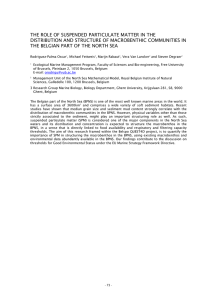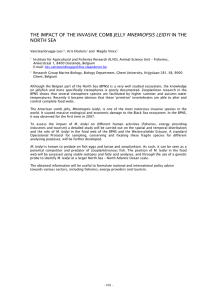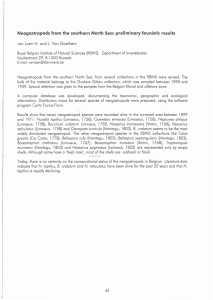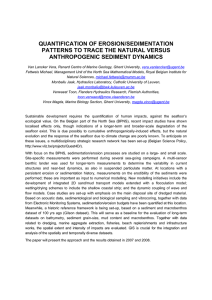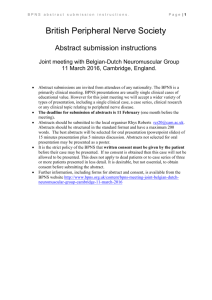CHAPTER 2 U
advertisement
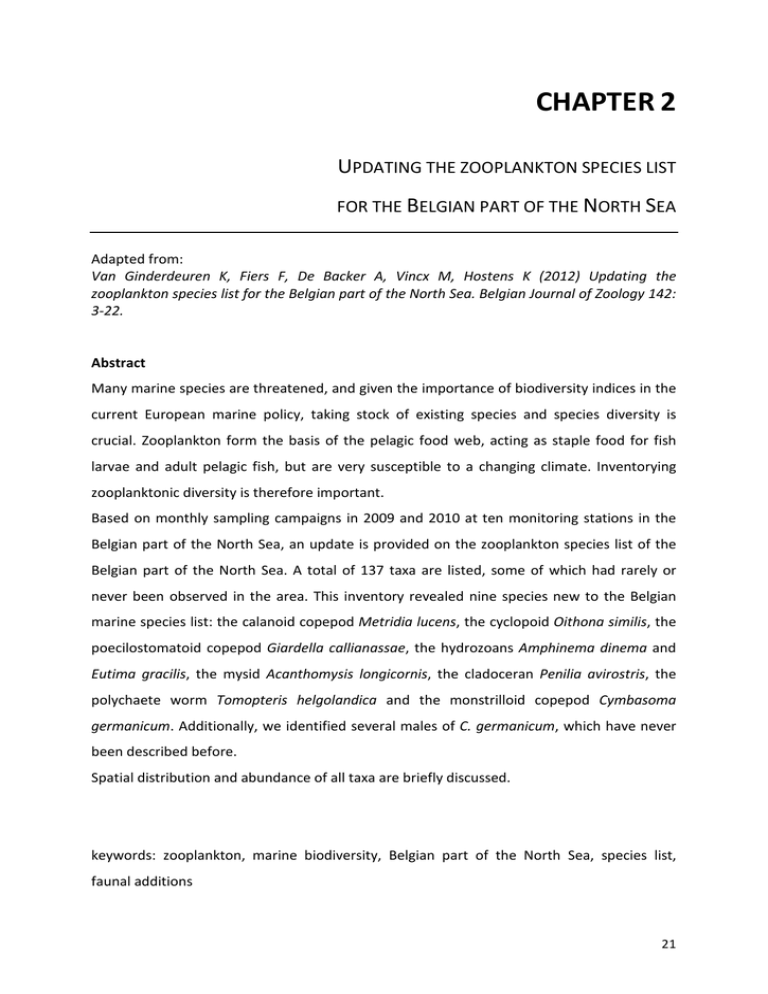
CHAPTER 2 UPDATING THE ZOOPLANKTON SPECIES LIST FOR THE BELGIAN PART OF THE NORTH SEA Adapted from: Van Ginderdeuren K, Fiers F, De Backer A, Vincx M, Hostens K (2012) Updating the zooplankton species list for the Belgian part of the North Sea. Belgian Journal of Zoology 142: 3-22. Abstract Many marine species are threatened, and given the importance of biodiversity indices in the current European marine policy, taking stock of existing species and species diversity is crucial. Zooplankton form the basis of the pelagic food web, acting as staple food for fish larvae and adult pelagic fish, but are very susceptible to a changing climate. Inventorying zooplanktonic diversity is therefore important. Based on monthly sampling campaigns in 2009 and 2010 at ten monitoring stations in the Belgian part of the North Sea, an update is provided on the zooplankton species list of the Belgian part of the North Sea. A total of 137 taxa are listed, some of which had rarely or never been observed in the area. This inventory revealed nine species new to the Belgian marine species list: the calanoid copepod Metridia lucens, the cyclopoid Oithona similis, the poecilostomatoid copepod Giardella callianassae, the hydrozoans Amphinema dinema and Eutima gracilis, the mysid Acanthomysis longicornis, the cladoceran Penilia avirostris, the polychaete worm Tomopteris helgolandica and the monstrilloid copepod Cymbasoma germanicum. Additionally, we identified several males of C. germanicum, which have never been described before. Spatial distribution and abundance of all taxa are briefly discussed. keywords: zooplankton, marine biodiversity, Belgian part of the North Sea, species list, faunal additions 21 CHAPTER 2 1. Introduction Biological diversity plays a crucial role in the way ecosystems function and in the many services they provide (Vitousek et al. 1997, Loreau et al. 2001). Loss of marine biodiversity locally, regionally and globally reduces the capacity of marine ecosystems to support the provision of goods and services, essential for human well-being (Cochrane et al. 2010). Species lists are therefore an indispensable fundamental tool to study species diversity and to calculate biodiversity indices in ecological studies. The pelagic zone is the biggest habitat in the world, and also the biggest for Belgium (Costello et al. 2010). Not only is it big, it is also ecologically very important, since the vast majority of fish species have a pelagic larval phase, including commercial fishes such as sole Solea solea, plaice Pleuronectes platessa and cod Gadus morhua (Russell 1976). These fish species must keep in step with their zooplanktonic food sources, for this is what their larvae eat. Furthermore, zooplanktonic organisms are very susceptible to a changing climate. The replacement of the cold water Calanus finmarchicus species assemblage in the North Sea by the warmer water C. helgolandicus-dominated copepod assemblage, with lower biomass and smaller species, is a text book example of the severe consequences of a warming climate on marine ecosystems (Richardson 2008). For the Belgian part of the North Sea (BPNS) very few historical lists of zooplankton species are available. The oldest known marine zooplankton samples date from the early 20th century (Gilson collection, discussed in Van Loen and Houziaux 2002). However, there was little to nothing published about the zooplanktonic species in these samples, as the main focus was on benthic organisms. Van Meel (1975) was the first to report zooplanktonic species lists from the Belgian part of the North Sea and adjacent waters, yet the data in this older benchmark study are qualitative instead of quantitative, hence they serve best for presence-absence comparisons. Albeit often unclear where exactly the samples originated from.1 1 Van Meel produced a lot of info on zooplankton in the southern North Sea and his thesis (1975) is by far the most detailed work on zooplankton we came across. It was our initial intention to compare our species list with his vast amount of species info. Yet after thoroughly studying his work it became clear that it is very difficult to be sure where exactly his species info relates to. His campaigns consisted of long transects and most of his samples seem to have originated from waters outside the BPNS. This makes it often difficult to draw conclusions when for example one species was present in his study and absent in our data. In the discussion of this chapter we compare our data with Van Meel where possible. For the calanoid copepod Calanus finmarchicus we were able to present detailed info on its disappearance from the southern North Sea by verifying Gilson samples (more than a century old) as well as Van Meel specimens and data. 22 ZOOPLANKTON SPECIES LIST More recent zooplanktonic research in Belgium has mainly focused on a limited number of species (e.g. Vandendriessche et al. 2006, Van Hoey 2006), on diurnal zooplankton behavior (Daro 1974, 1985a,b) or on the interaction of calanoid copepods with the harmful alga Phaeocystis globosa (Scherffel, 1899) (e.g. Gasparini et al. 2000, Antajan 2004, Daro et al. 2006, Rousseau et al. 2006). In contrast, the zooplankton community structure and its dynamics in the Scheldt estuary have received considerably more attention (e.g. Bakker and De Pauw 1975, Soetaert and Van Rijswijk 1993, Appeltans et al. 2003, Azémar et al. 2004, Tackx et al. 2004, Maes et al. 2005, Tackx et al. 2005), but recent data on the marine part of the BPNS are extremely scarce. Considering climate change, the importance of biodiversity and the biogeographical changes in the distribution of planktonic species, an update of the zooplankton species list for the BPNS is certainly timely. In 2010, the Flanders Marine Institute (VLIZ) compiled a species list for the Belgian marine waters (Vandepitte et al. 2010). For many zooplanktonic groups, the list is solely based on literature and therefore the current geographical distribution of many species is unverified. This study yields new and upto-date information about the composition of zooplankton in the transitional region between the Atlantic Ocean and the North Sea and provides additional information for the Belgian Register of Marine Species (BeRMS) (VLIZ Belgian Marine Species consortium 2010). 2. Materials And Methods 2.1 Sampling Sampling was carried out monthly in 2009 and 2010 at ten monitoring stations in the BPNS positioned along a nearshore-midshore-offshore axis (Fig. 1). A WP2 net (57 cm, 200 μm mesh size, Fraser 1968) fitted with flow meter (Smith et al. 1968) was towed in an oblique haul from bottom to surface. Samples were fixed and preserved in a 4 % formaldehyde solution. Data are derived from a selection of 112 samples (53 nearshore, 30 midshore, 29 offshore), taken in salinity ranges from 29.9 – 35.0 PSU and temperature ranges from 2.0 – 20.9 °C. 23 CHAPTER 2 Figure 1: A) North Sea exclusive economic zones; B) Belgian part of the North Sea (BPNS) with ten stations (situated in nearshore W01-04-midshore W05-07-offshore areas W08-10) sampled monthly for zooplankton from January 2009 to December 2010. 2.2 Species list Using compound- and stereo-microscopes, taxa were identified to species level when possible, in order to attain the highest taxonomical resolution. The classification used is according to the World Register of Marine Species (WoRMS) (Appeltans et al. 2011). Species that form an addition to the recently published Belgian Register of Marine Species (Vandepitte et al. 2010) are indicated in Table 1. In addition, the different taxa have been subdivided according to their lifestyle. We distinguish between holoplanktonic (spend their entire life as plankton in the water column, e.g. calanoid copepods), meroplanktonic (spend a part of their life as plankters, e.g. decapod larvae) and tychoplanktonic taxa (are occasionally carried into the water column, e.g. benthic species). Certain species groups such as mysids, amphipods and cumaceans that are often referred to as hyperbenthic, were also 24 ZOOPLANKTON SPECIES LIST counted as tychoplanktonic. Decapod larvae were lumped and not identified to species level, since pigmentation (necessary for identification) disappears due to fixation in formaline. 3. Results and discussion Table 1 lists 137 taxa (98 identified to species level) found in the Belgian part of the North Sea in 2009 and 2010, of which 46 are considered holoplanktonic, 50 meroplanktonic and 41 tychoplanktonic. Four copepods, two hydrozoans, one cladoceran, one mysid and one polychaete have never been reported from the BPNS and are new for the Belgian Register of Marine Species. Additional info on densities and the spatial and temporal occurrence of these taxa in the BPNS is presented in Addendum 1. Table 1: List of holo- (H), mero- (M) and tychoplanktonic (T) taxa in the BPNS observed in the period 2009-2010. Species with asterisk (*) are new to the Belgian fauna (Vandepitte et al. 2010). “LS” = lifestage. Higher Taxon Order Family Species LS Noctilucales Noctilucaceae Noctiluca scintillans (Macartney) Kofoid and Swezy, 1921 H Semaeostomeae Cyaneidae Cyanea lamarckii Péron and Lesueur, 1810 H Pelagiidae Chrysaora hysoscella (Linnaeus, 1767) H Dinoflagellata Noctilucea Cnidaria Scyphozoa Hydrozoa Ulmaridae Aurelia aurita (Linnaeus, 1758) H Rhizostomeae Rhizostomatidae Rhizostoma pulmo (Macri, 1778) H Anthoathecata Pandeidae Amphinema dinema (Péron and Lesueur, 1810)* H Bougainvilliidae Nemopsis bachei L. Agassiz, 1849 H Margelopsidae Margelopsis haeckeli (Hartlaub, 1897) H Rathkeidae Rathkea octopunctata (M. Sars, 1835) H Corynidae Sarsia tubulosa (M. Sars, 1835) H Campanulariidae Clytia hemisphaerica (Linnaeus, 1767) H Obelia sp. H Eucheilota maculata Hartlaub, 1894 H Lovenellidae sp. H Eutima gracilis (Forbes and Goodsir, 1853)* H Leptothecata Lovenellidae Eirenidae Eutonina indicans (Romanes, 1876) H Beroidae Beroe gracilis (Künne, 1939) H Bolinopsidae Mnemiopsis leidyi (A. Agassiz, 1865) H Pleurobrachiidae Pleurobrachia pileus (O. F. Müller, 1776) H Platyhelminthes Platyhelminthes sp. T Nemertea Nemertea sp. T Oligochaeta sp. T Tomopteris (Johnstonella) helgolandica (Greeff, 1879)* H Ctenophora Beroida Annelida Oligochaeta Polychaeta Phyllodocida Tomopteridae 25 CHAPTER 2 Mollusca Gastropoda Gastropoda sp. M Bivalvia Bivalvia sp. M Pectinoida Pectinidae Pectinidae sp. M Euheterodonta Pharidae Ensis sp. M Myopsida Loliginidae Loligo sp. M Acarina sp. T Bosminidae Bosmina sp. H Podonidae Evadne sp. H Podon sp. H Penilia avirostris Dana, 1849* H Acartiidae Acartia (Acartiura) clausi (Giesbrecht, 1889) H Calanidae Calanus helgolandicus (Claus, 1863) H Candacidae Candacia armata (Boeck, 1872) H Centropagidae Centropages hamatus (Lilljeborg, 1853) H Centropages typicus (Krøyer, 1849) H Isias clavipes (Boeck, 1865) H Pontellidae Labidocera wollastoni (Lubbock, 1857) H Metridinae Metridia lucens (Boeck, 1865)* H Paracalanidae Paracalanus parvus (Claus, 1863) H Clausocalanidae Pseudocalanus elongatus (Boeck, 1865) H Temoridae Temora longicornis (Müller O.F., 1785) H Corycaeidae Corycaeus anglicus (Lubbock, 1857) H Cyclopinidae Cyclopinoides littoralis (Brady, 1872) H Oithonidae Oithona nana (Giesbrecht, 1893) H Oithona similis (Claus, 1866)* H Oncaea sp. H Crustacea Arachnida Branchiopoda Copepoda Diplostraca Calanoida Cyclopoida Oncaeidae Harpacticoida Harpacticoida sp. T Euterpinidae Euterpina acutifrons (Dana, 1847) H Monstrilloida Monstrillidae Cymbasoma germanicum (Timm, 1893)* H Poecilostomatoida Clausidiidae Giardella callianassae Canu, 1888* M Cirripedia sp. M Euphausiacea Euphausiidae Nyctiphanes couchii (Bell, 1853) H Anomura sp. M Brachyura sp. M Caridea sp. M Decapoda sp. M Callianassidae Callianassa sp. M Crangonidae Crangon crangon (Linnaeus, 1758) M Porcellanidae Pisidia longicornis (Linnaeus, 1767) M Processidae Processa modica Williamson, 1979 T Bodotriidae Bodotria arenosa (Goodsir, 1843) T Bodotria scorpioides (Montagu, 1804) T Diastylidae Diastylis rathkei (Krøyer, 1841) T Pseudocumatidae Pseudocuma sp. T Cirripedia Eucarida Decapoda Peracarida 26 Cumacea ZOOPLANKTON SPECIES LIST Amphipoda Monopseudocuma gilsoni (Gilson, 1906) T Pseudocuma (Pseudocuma) longicorne (Bate, 1858) Pseudocuma (Pseudocuma) simile G.O. Sars, 1900 T Hyperiidae Hyperia galba (Montagu, 1815) H Amphilochidae Amphilochus neapolitanus Della Valle, 1893 T Calliopiidae Apherusa bispinosa (Bate, 1857) T Apherusa ovalipes Norman and Scott, 1906 T Atylus falcatus (Metzger, 1871) T Atylus swammerdami (Milne-Edwards, 1830) T Pontopereiidae Bathyporeia sp. T Corophiidae Corophium sp. T Gammaridae Gammarus crinicornis (Stock, 1966) T Gammarus salinus (Spooner, 1947) T Caprella linearis (Linnaeus, 1767) T Atylidae Caprellidae Pariambus typicus (Krøyer, 1884) T Ischyroceridae Jassa herdmani (Walker, 1893) T Leucothoidae Leucothoe incisa (Robertson, 1892) T Megaluropidae Megaluropus agilis (Hoeck, 1889) T Microprotopidae Microprotopus maculatus (Norman, 1867) T Orchomenella nana (Kroyer, 1846) T Pontocrates altamarinus (Bate and Westwood, 1862) Pontocrates arenarius (Bate, 1858) T Isopoda sp. M Cirolanidae Eurydice spinigera Hansen, 1890 T Mysidae Acanthomysis longicornis (Milne-Edwards, 1837)* T Anchialina agilis (G.O. Sars, 1877) T Gastrosaccus sp. T Gastrosaccus sanctus (van Beneden, 1861) T Gastrosaccus spinifer (Goës, 1864) T Mesopodopsis slabberi (van Beneden, 1861) T Schistomysis kervillei (G.O. Sars, 1885) T Schistomysis ornata (G.O. Sars, 1864) T Schistomysis spiritus (Norman, 1860) T Oedicerotidae Isopoda Mysida Chaetognatha Echinodermata T T Siriella armata (Milne-Edwards, 1837) T Tanaidacea Tanaidae Tanais dulongii (Audouin, 1826) H Aphragmophora Sagittidae Parasagitta elegans (Verrill, 1873) H Parasagitta setosa (Müller, 1847) H Camarodonta Parechinidae Psammechinus miliaris (P.L.S. Müller, 1771) M Forcipulatida Asteriidae Asterias rubens Linnaeus, 1758 M Ophiurida Ophiotrichidae M Ophiuridae Ophiothrix fragilis (Abildgaard, in O.F. Müller, 1789) Ophiura sp. Loveniidae Spatangoida M Echinocardium sp. M Bryozoa Bryozoa sp. M Phoronida Phoronida sp. M Chordata 27 CHAPTER 2 Tunicata Copelata Oikopleuridae Oikopleura (Vexillaria) dioica Fol, 1872 H Cephalochord ata Pisces Amphioxiformes Branchiostomidae Branchiostoma lanceolatum (Pallas, 1774) M Pisces sp. M Perciformes Ammodytidae Ammodytidae sp. M Ammodytes marinus Raitt, 1934 M Ammodytes tobianus Linnaeus, 1758 M Hyperoplus lanceolatus (Le Sauvage, 1824) M Callionymidae Callionymus sp. M Trachinidae Echiichthys vipera (Cuvier, 1829) M Trachinus draco (Linnaeus, 1758) M Gobiidae sp. M Pomatoschistus sp. M Carangidae Trachurus trachurus (Linnaeus, 1758) M Bothidae Arnoglossus laterna (Walbaum, 1792) M Soleidae Buglossidium luteum (Risso, 1810) M Solea solea (Linnaeus, 1758) M Limanda limanda (Linnaeus, 1758) M Pleuronectes platessa Linnaeus, 1758 M Clupeidae sp. M Clupea harengus Linnaeus, 1758 M Sardina pilchardus (Walbaum, 1792) M Sprattus sprattus (Linnaeus, 1758) M Gobiidae Pleuronectiformes Pleuronectidae Clupeiformes Clupeidae Engraulidae Engraulis encrasicolus (Linnaeus, 1758) M Gadiformes Gadidae Merlangius merlangus (Linnaeus, 1758) M Osmeriformes Osmeridae Osmerus eperlanus (Linnaeus, 1758) M Syngnathiformes Syngnathidae Syngnathus rostellatus Nilsson, 1855 M Scorpaeniformes Triglidae Triglidae sp. M 3.1 Species new for the BPNS Cymbasoma germanicum is a rare monstrilloid species known only from a few female specimens collected at the Doggersbank, off Helgoland (in 1892) and Cuxhaven (Razouls et al. 2005-2011, Suárez-Morales 2006). Monstrilloid copepods are protelean parasites of benthic macroinvertebrates such as polychaetes and mollusks (Davis 1984). Protelean parasites start as (often internal) parasites that continue their lives as free living adults after killing or consuming the host. We found 16 specimens, both males and females (Fig. 2). The differences between C. germanicum, Cymbasoma rigidum Thompson, 1888 and Cymbasoma zetlandicus T. Scott, 1904 are subtle. Cymbasoma germanicum can be distinguished from the different morphotypes related to the nominal species Cymbasoma rigidum by a combination of characteristics, including a large inner lobe of the fifth leg, an innermost fifth leg seta nearly 28 ZOOPLANKTON SPECIES LIST as long as the other two, the relative length of the antennules, and the shape of the second antennular segment. The main distinguishing character is the presence of two knob-like processes (Fig. 3) on the posterior margin of the genital somite (Suárez-Morales 2006). A redescription, including the description of the male, and comparison with its close relatives is planned for the future (Fiers and Van Ginderdeuren in prep.). Metridia lucens is a copepod most found in the northern North Sea and northern Atlantic (Fraser 1965, Barnard et al. 2004). Its occurrence in the southern part of the North Sea, appears to be scanty: Van Meel (1975) detected the species in 1902-1910 samples. Brylinski (2009) reported the find of a single male specimen in the Strait of Dover over a period of 30 years and Fransz (2000) emphasized the low abundance of the copepod among the zooplankton in the Dutch part of the North Sea. 29 CHAPTER 2 Figure 2: Cymbasoma germanicum female and male habitus drawn from specimens collected in the BPNS. A-B: Female, dorsal and lateral view; C-D: Male, dorsal and lateral view (Fiers and Van Ginderdeuren in prep.). 30 ZOOPLANKTON SPECIES LIST Figure 3: Cymbasoma germanicum male urosome habitus drawn from specimens collected in the BPNS. A: Dorsal view; B lateral view; C: ventral view; D: anus (Fiers and Van Ginderdeuren in prep.). Van Meel (1975) considered Oithona similis as a species typical for the central part of the North Sea. In the southern part O. similis was reported near Gravelines (Antajan 2008) and in the Solent, English Channel (Muxagata and Williams 2004). Van Meel (1975) however reported this species from a transect between Blankenberge (Belgium) and Orfordness (England), indicating that O. similis was found in the BPNS region. Saphirella (Scott, 1894) morphs are now considered as the first copepodite stages (C1) of certain Clausiididae (Brylinski 2009). The adults of these pelagic larvae are parasitic Cyclopoida (Razouls et al. 2005-2011). Brylinski (2009) identified Saphirella specimens in the 31 CHAPTER 2 English Channel corresponding to C1 of Giardella callianassae, a species never reported from Belgian waters (Vandepitte et al. 2010). These Giardella copepodites were also found in high numbers in our samples (Addendum 1). The hydrozoan Amphinema dinema was collected by Gilson near Calais in 1905 (mentioned by Van Meel 1975). Fraser (1965) found A. dinema in the English Channel. Its presence off the Belgian coast was reported previously (Leloup 1952) but the species was omitted in the Belgian Register of Marine Species. The present study confirms its presence in the BPNS. Eutima gracilis is a hydrozoan not mentioned from the North Sea and the English Channel by Fraser (1965) and Van Meel (1975), but it has been observed in English waters by others (Russell 1953, Medin 2011). It appears to be restricted to European waters. The mysid Acanthomysis longicornis has been observed in the vicinity of the BPNS. Mees et al. (1993) found it in the Westerschelde estuary close to the Belgian border, Müller (1994) found it in Wimereux and Zimmer (1933) as well reported A. longicornis from the southern North Sea. Penilia avirostris is an abundant and widely distributed cladoceran in neritic tropical and subtropical waters, which has expanded north to temperate latitudes in the 20th century (Atienza et al. 2008). Johns et al. (2005) described how P. avirostris has increased in the North Sea since 1999, most probably due to warmer sea surface temperatures. The eggcarrying female found in this study proves that this species occurs and reproduces in the Belgian part of the North sea. Evadne nordmanni is a cladoceran not mentioned in the BeRMS (Vandepitte et al. 2010) and as such could be regarded as new for Belgian waters. However, Van Meel (1975) reports it present in high numbers in the BPNS in the early 20th century, indicating that this species has been found in the past. Tomopteris (Johnstonella) helgolandica is the only holoplanktonic polychaete in the southern North Sea. It is known from Dutch waters, although rare (Fransz 2000), and in the English Channel near Wimereux (Dauvin et al. 2003). 3.2 Additional observations The most abundant copepods were the calanoids Acartia clausi, Temora longicornis, Paracalanus parvus, Centropages hamatus, Pseudocalanus elongatus and the harpacticoid 32 ZOOPLANKTON SPECIES LIST copepod Euterpina acutifrons. This corresponds with the observations by Van Meel (1975), Daro et al. (2006) and Brylinski (2009). In the North Sea, Calanus finmarchicus has shifted progressively northwards, while C. helgolandicus became more abundant and widely distributed in the 1980s (Reid et al. 2003). In 2009-2010 only C. helgolandicus and not C. finmarchicus occurred in the samples taken in the BPNS, corresponding with the results of Brylinski (2009) finding only the former species of Calanus. Van Meel (1975) on the other hand, mentions the calanoid C. finmarchicus attaining high densities in the southern North Sea in the ‘70s, while in the 19th century Canu (1892) reported only C. finmarchicus from the Boulonnais. Sars (1903) reported “C. helgolandicus has been recorded from the western coast of France by Dr. Canu”, suggesting he did not agree with Canu’s identification. This indicates that confusions exist in older literature between the two species C. helgolandicus and C. finmarchicus. We investigated Calanus specimens from Van Meel (1975), sampled in the vicinity of the BPNS in the early 20th century (stored in the RBINS collections in Brussels). They were C. finmarchicus, in contrast to the C. helgolandicus in our 2009 and 2010 samples. In the present study, C. helgolandicus typically occurred around/on the offshore stations and was only occasionally caught nearshore. This copepod is known to reach high densities in the English Channel (Barnard et al. 2004), and is often transported to the BPNS by prevailing marine currents conveying Atlantic water through the English Channel towards the southern North Sea (Howarth 2001). Parasagitta elegans is a chaetognath from the Atlantic Ocean and the more boreal parts of the North Sea (Fraser 1965). Van Meel (1975) describes how the species sometimes occurs in the English Channel when conveyed in Atlantic currents reaching the North Sea. The fact that we caught only one individual of P. elegans while many thousands of P. setosa suggests that it is (or has become) a very rare species. Although species discrimination in chaetognaths is difficult, the present study confirms the presence of P. elegans in the BPNS. Nyctiphanes couchii is the only euphausid recorded in the present study. It occurs in high densities in the central and northern North Sea, straying into the BPNS, especially during the 33 CHAPTER 2 colder winter months (Russell 1935, Van Meel 1975). It has previously been reported from Belgian waters by Cattrijsse and Vincx (2001) and Lock et al. (2011). The non-indigenous ctenophore Mnemiopsis leidyi was first reported from the North Sea in Dutch coastal waters in August 2006 (Holsteijn 2002). Reports of autumn blooms of lobate ctenophores off the Dutch coast prior to the first M. leidyi sightings were previously attributed to Bolinopsis infundibulum (O.F. Müller, 1779) (Faasse and Bayha 2006). Whether M. leidyi was present along the Dutch coast before 2006 remains to be settled as the two ctenophores can easily be confused. Bolinopsis infundibulum is a cold-water species and considered rare along the Dutch coasts. It was only in August 2007 that M. leidyi was first seen in the BPNS, in the port of Zeebrugge (Dumoulin 2007). Because of its presence within the port, its introduction into Belgian waters is most probably related to ballast water transport in cargo ships, as was indicated for M. leidyi in the Black and Caspian Seas and in the Dutch part of the North Sea (Vinogradov et al. 1989, Ivanov et al. 2000, Faasse and Bayha 2006). Today, only four years after the first sighting/observation in 2007, M. leidyi occurs all along the Belgian coastline, up to 27 km offshore at the Thornton wind park as well as in all ports. Sightings of adult individuals in the coldest winter months imply that the species can survive Belgian winters (Also see Chapter 2 Annex 1 for info on M. leidyi). Another non-indigenous coelenterate recorded in this study is the hydrozoan Nemopsis bachei, a species generally considered to originate from the Atlantic coast of North America (Hargitt 1901). This hydrozoan naturally occurs in coastal areas and tolerates a wide array of salinities from 15 - 45 (75) PSU (Moore 1962). Nemopsis bachei was caught along the entire Belgian coastline, most abundantly around the port of Zeebrugge, where it was discovered in 1996 (Dumoulin 1997). Cyanea lamarckii is the most frequently observed scyphozoan in this study. Its occurrence is in accordance with other jellyfish studies in the southern North Sea (Barz and Hirche 2007). In contrast to other species of Scyphozoa encountered, this jellyfish reached its highest densities offshore rather than nearshore (Addendum 1). 34 ZOOPLANKTON SPECIES LIST Acknowledgements The authors are grateful to the Flanders Marine Institute (VLIZ), especially Dr. André Cattrijsse, for planning the sampling campaigns with RV Zeeleeuw. This study could not have taken place without the adept help of taxonomical experts verifying our work. We want to express our gratitude to Dr. Elvire Antajan for verifying the identification of copepod species, Prof. Dr. Jean-Michel Brylinski for help with hydrozoans and Giardella copepodites, Jan Wittoeck for checking tychoplanktonic species, Hans De Blauwe for the cnidarians, Steve Hay for giving advice on Mnemiopsis leidyi identification and Dr. Christophe Loots for verifying fish larvae. 35
